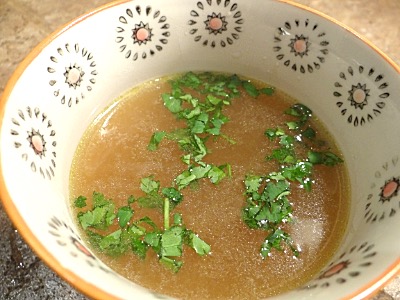- By Suzana Jelovecki
- Around Town
 Print
Print  A few weeks ago an article about bone broth benefits was published in the New York Times. Shots of fresh prepared, slow cooked bone stock have been served at several trendy places as an 'on the go meal' in the City. Grandmother's spirits from various cultures all over the world couldn't be more pleased with the fact that centuries old preindustrial food is gaining popularity outside of chef's kitchens and lifestyle's of whole food enthusiasts.
A few weeks ago an article about bone broth benefits was published in the New York Times. Shots of fresh prepared, slow cooked bone stock have been served at several trendy places as an 'on the go meal' in the City. Grandmother's spirits from various cultures all over the world couldn't be more pleased with the fact that centuries old preindustrial food is gaining popularity outside of chef's kitchens and lifestyle's of whole food enthusiasts.What is so magical and special in that simple traditional meal that challenges habits of consuming industrial and processed foods so dominant in an average American diet? Are you ready to face the facts and mineralize and enrich your meals with this simple and affordable potion?
Bone and meat brews were the staple of culinary evolution, most likely, from the time pots were invented. Not so long ago meat and vegetable supplies were scarce. Nothing went to waste. Knuckles, bones, carcasses, gizzards and tendon rich meat parts would be used to make nourishing liquid meals which were not only used as tasty food, but potent rescue remedies for curing illnesses, helping in recovery after child birth, building immunity and bone strength, and soothing the nervous system.
When harsh cold winters were matters of survival, stocks rich in collagen, amino acids and minerals, such as calcium, magnesium, phosphorus, silicon and trace minerals would prevent malnutrition, help absorption of proteins, and aid in optimal health. Good homemade soups bring back life.
In Chinese medicine dietary therapy slow cooked, gelatin-producing bone elixirs were used as targeted therapeutic protocols for various illnesses. Fish carcass stocks strengthens thyroid function and lungs. Beef and veal bones build the blood (increase WBC and RBC). Pork bones help in mending joint pain and nourish nervous system, particularly those presented with heat symptoms, as seen in rheumatoid arthritis or multiple sclerosis. Lamb bone broth warms the body and helps regain strength, and chicken broths aid digestion capacities and help in recovery from respiratory tract infections and in postpartum times.
Unfortunately, all of these health benefits of homemade broths were lost when the food industry, sometime in the middle of the last century, started to play with our taste buds by producing synthesized food flavors. MSG (monosodium glutamate) was born.
MSG resembles meat flavor and is usually produced from inexpensive grain and legume proteins by hydrolization. Although banned from the market as a nerve damaging agent, ironically enough, profit driven food industries haven't given up from the 'flavorful' abilities of MSG. Instead, it has just kept playing an impudent legal word game and has labeled it as a hydrolyzed protein. All those bouillon cubes, powdered soups and sauces, flavored chips, and fast food products became the aromatic fraud and nourishment-depriving agents of our modern diet.
If are interested in making real homemade broth, here is some advice on how to (re)introduce this ancient wisdom into your modern kitchen. Preparation is really simple. Benefits of the wholeness and integrity of natural ingredients will enhance your gourmet cooking skills and add to the health and agility of all your family members. Stocks can be used in endless recipes for aromatic soups, tasty sauces, rich stews, stir-fries, and as a shot of 'brothesso' on the go to warm your heart and soul.

1. You will need a large pot and good quality water. Get all meat ingredients from grass-fed animals, preferably grown by small local, organically certified farmers. Chicken bones from commercial poultry producers will never dissolve into gelatin -- try it if you want to experiment! Use vegetables such as onions, carrots, celery, celeriac, and parsnips as a base. Add any others according to your taste and preferences. I sometimes use medicinal berries and roots to enhance healing properties of the brew, including goji berries, astragalus, ginseng, Dong Quai roots, shi-take mushrooms, or seaweeds.
2. Place all the ingredients in cold water then bring the brew to a boil. Lower the heat and simmer your elixir at least a couple of hours. Fish heads and carcasses need 2 hours or so to become gelatinous, poultry bones will need 4-10 hours, and harder bones (beef, pork, lamb) will dissolve well overnight or by cooking them even longer. Beef and lamb bones can be browned in the oven for enhanced flavor before simmering. Add a few tablespoons of vinegar or wine at the beginning of the cooking to help the breakdown of proteins and to speed up the softening of the bones and cartilages. Vegetables, like mushrooms and medicinal plants can be added later. In the last ten minutes of simmering toss in herbal spices of your choice to augment the flavor.
3. Cooked stock will look somewhat messy and non-appealing, but when you remove all the remaining ingredients using a strainer, a rich golden yellow or brownish liquid will surprise you with the taste and flavor incomparable to any of the commercially made broths and powdered soups. You can chill the broth and then remove any excess fat, which will float on the surface. It can be stored a few days if refrigerated, or for a few months if frozen in an air tight container.
Recipe for Chicken Stock
1 whole chicken's carcass
2 chicken necks
Chicken gizzard (optional- adds yummy sweet taste to the brew)
Onion or smaller leek stalk- coarsely chopped
3-4 big carrots- sliced in ½ inch pieces
4 celery stalks – cut in 2inch pieces
¼ of celeriac root-cut in chunks
1 kohlrabi-cut in chunks
1 gallon of water
3-4 dried bay leaves
Handful of goji berries (optional)
Sea or Himalayan salt to taste
2 tbs of vinegar
2tbs of finely chopped parsley or cilantro
Follow the instructions described above; cooking time 4-10 hours; when strained garnish with chopped parsley or cilantro; Enjoy!
Bonus culinary information: A broth is a brew with more meat content, whereas stock is made mostly of the bones and cartilages.
v11i4
Suzana Jelovecki, MS, Licensed Acupuncturist, is the owner of Roots and Branches Acupuncture and Nature Bound Woman
